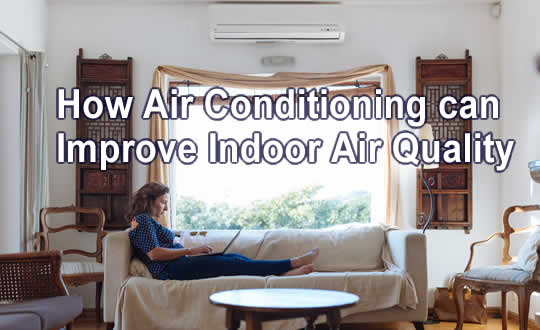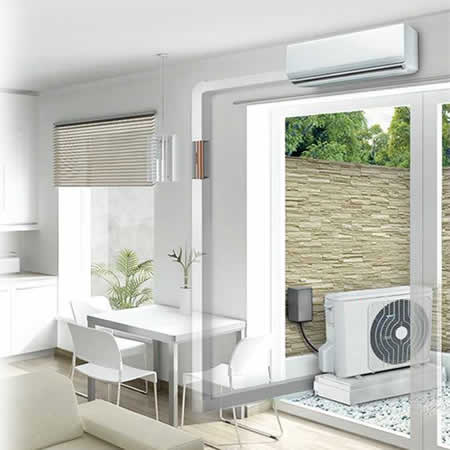How Air Conditioning Can Improve Indoor Air Quality
If you were concerned about how air conditioners and indoor air quality are related, here is some information on the relationship between them that may help you.
The quality of the air inside your home and also the place that you work in can have an impact on respiratory health either positively or negatively depending on how clean or otherwise it is.
 There are a number of factors that will dictate how clean the air you breathe is inside or out, from environmental to the state of the local weather at varying times throughout the year.
There are a number of factors that will dictate how clean the air you breathe is inside or out, from environmental to the state of the local weather at varying times throughout the year.
Can your air conditioning equipment make a difference in your indoor air's quality?
Let's take a look and see.
Indoor Air Pollutants
It may come as a pleasant surprise to learn that most modern air conditioning systems are fitted with air filters to trap airborne particulates that may be considered harmful to respiratory health. These particulates or pollutants come in a number of forms, for example:
- Common household dust
- Building materials
- Newly installed flooring
- Carpets or rugs
- Soft furnishing materials
- Modern wooden furniture
- Tobacco products
- Pet hairs and dander
- Cleaning products
- Air freshener sprays
- Smoke from open fires or furnaces
- Unvented gas from heating devices and cookers
- Frying oil and some airborne cooking particulates
- Excess moisture
It is possible to minimize the spread of airborne particulates from these sources through effective venting or reduced use of harmful chemicals in the home and regular vacuuming with a cleaner fitted with a high grade hepa filter. However, there will always be some level of pollutants present in indoor air from some of the above sources that can further be reduced or eliminated by the filtering effect of good quality air conditioning equipment.
Air Conditioning Air Filtering
Central air conditioning or zoned mini-split air conditioners are generally most effective at cleaning the air as they not only filter the air passing through them but exhaust processed air directly out of the building. Portable units fitted with good filters can also have a positive effect when vented correctly through factory-made window venting kits or custom through-wall vents.
 What can't be effectively filtered are the gaseous pollutants that emanate from such sources as cleaning chemicals, unburned unvented gasses from gas heaters and cookers and the vapors emitted from certain modern woods and wood coatings, furnishings and flooring. However, the venting action by air conditioners that exhaust air out of the building can have the effect of reducing the level of this type of pollutant.
What can't be effectively filtered are the gaseous pollutants that emanate from such sources as cleaning chemicals, unburned unvented gasses from gas heaters and cookers and the vapors emitted from certain modern woods and wood coatings, furnishings and flooring. However, the venting action by air conditioners that exhaust air out of the building can have the effect of reducing the level of this type of pollutant.
It can also be argued that keeping windows open will help to circulate the air inside and help carry pollutants out of the building while replenishing indoor air with fresh air from outside. This is fine when the outdoor temperature is comfortable, but if it is very hot, this will also heat up the interior of your home or work space.
When windows need to be kept closed to keep out the heat and help the air conditioning to run more efficiently, it is left to the cooling system to expel as much of the airborne toxins as it can realistically deal with. This is far better than no air circulation with the outside at all.
Removing Moisture with Air Conditioning
One aspect of interior air quality that air conditioners are actually very good at is reducing the level of atmospheric moisture (water vapor) inside a building space. By the very nature of the air cooling process, moist air is extracted from the internal air space and condensed to liquid form to be drained outside the building, while colder, dry air is re-introduced into the room.
This greatly helps the quality of the air by reducing the appearance of mold, thus also reducing the ability of mold spores to be released into the atmosphere. Mold spores present in a damp living atmosphere are responsible for a number of respiratory infections and conditions, so by reducing their presence also greatly reduces the health problems they can cause.
Evaporative Coolers and Air Quality
If your home is cooled with evaporative coolers (often erroneously called "ventless portable air conditioners") instead of air conditioning, there are certain areas where positive effects can still be enjoyed, although there are also some negatives to contend with.
The downside to swamp coolers is the fact that they increase the humidity inside the space being cooled, thus creating a more agreeable habitat for mold to grow.
This problem can be reduced significantly by doing the opposite to help air conditioning and opening windows to create a cross draft and circulate moist air out of the building. Thanks to the low energy consumption of swamp coolers, there is little waste by having windows open a little as the hot air from outside is quickly chilled as it enters the cooler without any extra energy usage, unlike that with air conditioning.
Modern, good quality evaporative coolers are generally fitted with high grade filters to trap much of the room's airborne particulates allowing for cleaner air to be circulated in the cooling space.
Conclusion
Air quality indoors can be improved considerably by the filtering and air circulation of air conditioning equipment, while internal air is naturally dried as a normal part of the condensing phase of the air conditioning process. This helps reduce both airborne pollutants and moisture-loving mold in the home and indoor working environments.